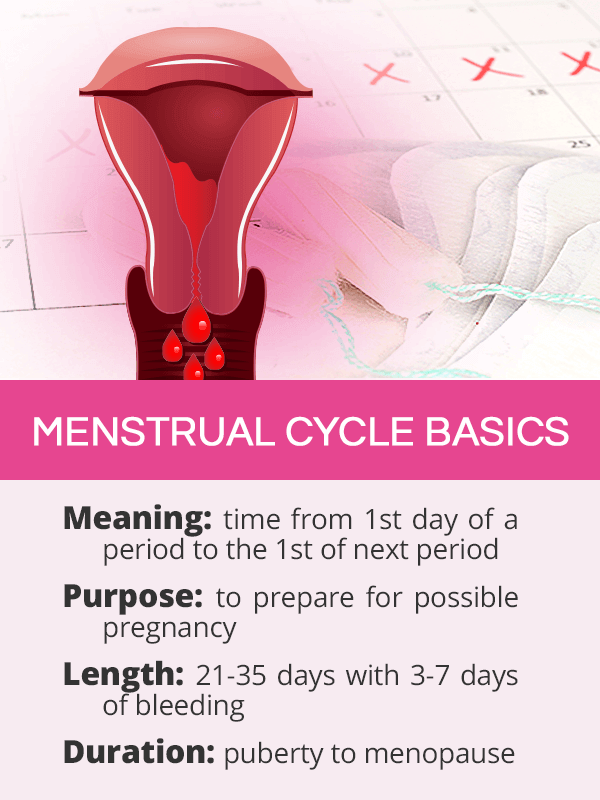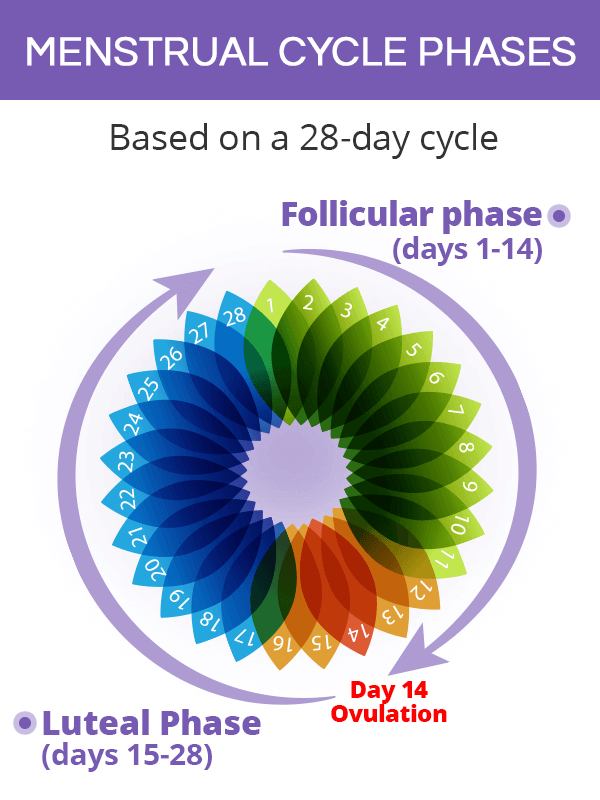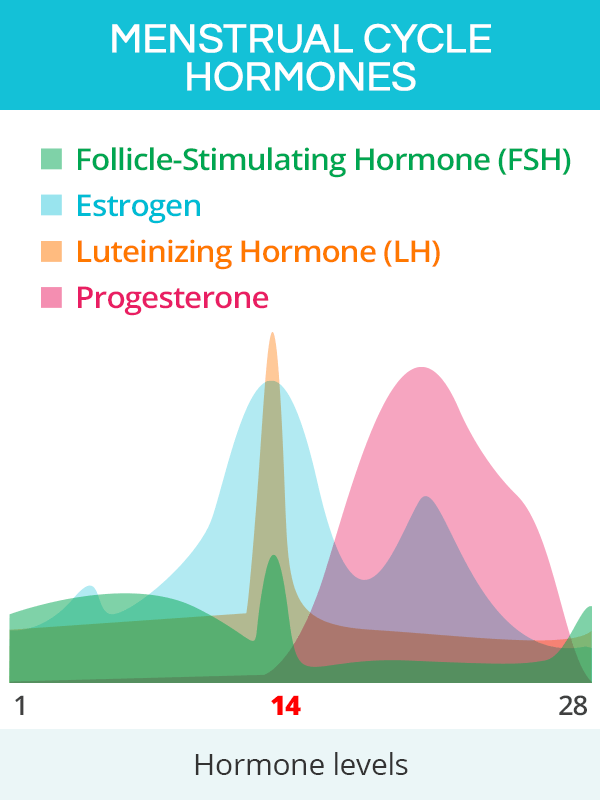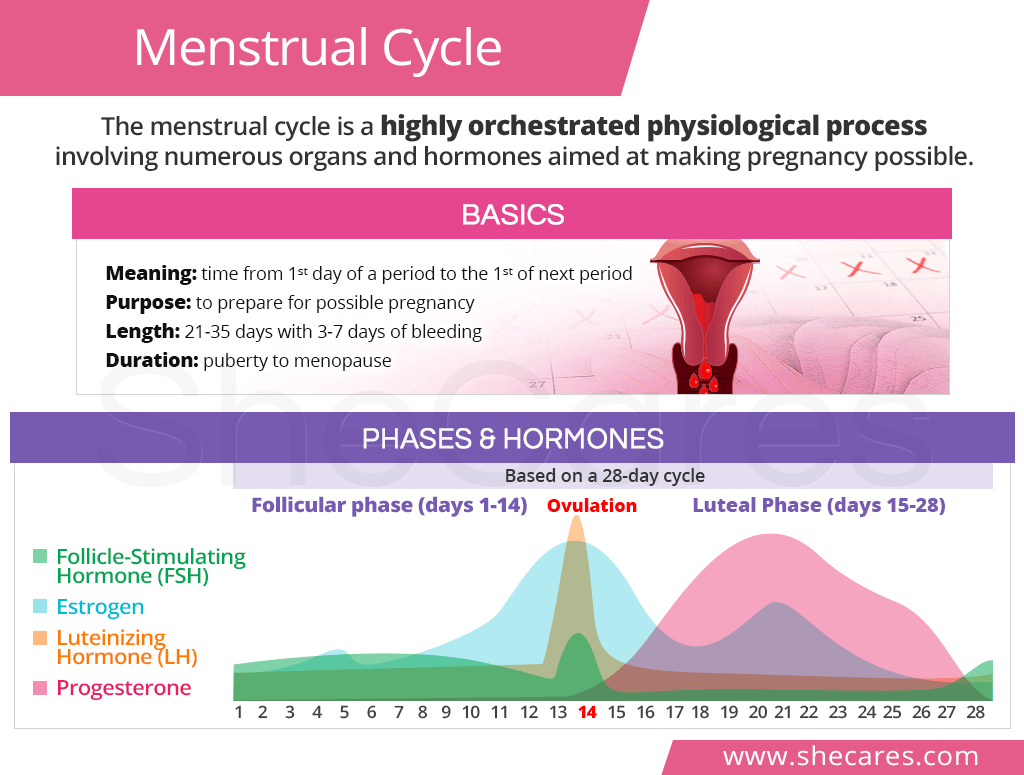Menstrual Cycle Basics

Before getting into the intricate details of what goes on in an average female cycle, it is worth brushing up on some menstrual cycle basics.
Menstrual Cycle Meaning
Menstruation, also called a period or menses, is a monthly discharge of blood and endometrial tissue. Period length ranges from for 3-7 days with 5 being the average.1 A menstrual cycle is the time from the first day of a period to the first day of the next.
Why Do Women Menstruate?
From a biological standpoint, the purpose of the menstrual cycle and all of the hormone-driven physiological changes that occur in the body is to prepare the body for a possible pregnancy.
How Long Do Women Menstruate?
Women menstruate from puberty until menopause, defined as 12 consecutive months without a period. The average age of puberty is 11, while for menopause, it is 51.2,3
Menstrual Cycle Length
Though every woman's length varies, a menstrual cycle is considered healthy when it lasts between 21 to 35 days, with 28 days being the average.1
Anything that falls outside this range is considered an irregular period and - if other symptoms are present - could be indicative of an underlying menstrual disorder, like premenstrual syndrome (PMS) or premenstrual dysphoric disorder (PMDD). As such, it requires prompt evaluation.
Menstrual Cycle Phases

For simplicity, the following breakdown is based on a 28-day menstrual cycle. It is divided into two phases: follicular and luteal with ovulation occurring right in between.
Follicular Phase (Days 1-14)
The first menstrual phase is called the follicular phase. It starts on the first day of a period and lasts until ovulation.
As aforementioned, the bloody discharge that leaves the body is actually the remains of the endometrium from the previous menstrual cycle.
During the follicular phase, the ovaries mature the follicles (sacs that contain the eggs) from their ovarian reserve in preparation to release one egg on ovulation.
Meanwhile, the lining of the uterus, called the endometrium, starts to grow thicker and more vascular towards the second half of the follicular phase.
Ovulation (Day 14)
Although ovulation is not considered a distinct phase on its own, it is important to mention as it falls right in the middle of menstrual cycle phases. Ovulation takes about 12-24 hours, which is the only time during which fertilization can take place.1
Luteal Phase (Days 15-28)
With ovulation, the second menstrual phase starts, called the luteal phase. Whether fertilized or not, the egg will begin move down the fallopian tubes to the uterus. Until it reaches the uterus, the body does know yet if pregnancy has occurred.
Once a fertilized egg arrives at the uterus, it will begin to implant in the uterine lining, thus signaling the body that pregnancy has occurred.
If an unfertilized egg arrives at the uterus, it will pass through and be shed along with the endometrial lining about 14 days later during a woman's period. With that, the entire menstrual cycle repeats.
Menstrual Cycle Hormones

The aforementioned bodily events would not be possible without hormones. They are the driving force behind physiological changes that take place to enable reproduction.
There are four main reproductive hormones during the menstrual cycle, including:
Follicle-Stimulating Hormone (FSH)
On the first day of the follicular phase of the menstrual cycle, the pituitary gland in the brain triggers the release of FSH, whose rise - as the name suggest - will stimulate the ovaries to begin maturing the eggs within the follicles.
Estrogen
As the eggs in the follicles mature, they begin to release estrogen, which will peak a day or two before ovulation. Increasing estrogen triggers the endometrial thickening and stimulates the production of gonadotropin-releasing hormone (GnRH), which, in turn, triggers the pituitary gland to secrete luteinizing hormone (LH).
Luteinizing Hormone (LH)
LH continues to surge until it peaks about 36-48 hours before ovulation. It also triggers a short-lived surge of testosterone to boost libido, just in time for the most fertile part of the cycle.4
Progesterone
After ovulation, FSH and LH decrease. The remnants of the follicle that released the egg become a structure called the corpus luteum, which begins producing progesterone. If pregnancy occurred, progesterone will maintain the endometrial lining and prevent it from shedding. If pregnancy has not occurred, the corpus luteum will disintegrate, causing a drop in progesterone that initiates the entire menstrual cycle again, starting with the shedding of the egg and endometrial lining.
Key Takeaways
Though individual menstrual cycle patterns vary from woman to woman, a cycle is considered healthy when it is between 21 and 35 days long. It is divided into two phases, follicular and luteal, which begin on the first day of a period and end on the first day of the next period. Right in between them is ovulation, which is the only time in the cycle when a woman can conceive a baby. Behind that complex physiology are a handful of hormones, such as FSH, estrogen, and progesterone, which work in unison to prepare the body for a potential pregnancy. Any deviation along the way can result in a menstrual disorder and have a series of health consequences. Luckily, women can keep an eye on their menstrual patterns with period trackers, which will not only help them nurture their fertility, but also overall health.
Sources
- Annals of the New York Academy of Sciences. (2008). Menstrual Cycle: Basic Biology. Retrieved November 7, 2019 from https://www.ncbi.nlm.nih.gov/pmc/articles/PMC2913133/
- Better Health. (2018). Menstruation. Retrieved November 7, 2019 from https://www.betterhealth.vic.gov.au/health/conditionsandtreatments/menstrual-cycle
- Cleveland Clinic. (2019). Female Reproduction System. Retrieved November 7, 2019 from https://my.clevelandclinic.org/health/articles/9118-female-reproductive-system
- Endotext. (2018). The Normal Menstrual Cycle and the Control of Ovulation. Retrieved November 7, 2019 from https://www.ncbi.nlm.nih.gov/books/NBK279054/
- Health Direct. (2018). Menstruation (periods). Retrieved November 7, 2019 from https://www.healthdirect.gov.au/menstruation
- Medline Plus. (2019). Menstruation. Retrieved November 7, 2019 from https://medlineplus.gov/menstruation.html
- Mayo Clinic. (2019). Menstrual cycle: What's normal, what's not. Retrieved November 7, 2019 from https://www.mayoclinic.org/healthy-lifestyle/womens-health/in-depth/menstrual-cycle/art-20047186
- NHS. (2019). Fertility in the Menstrual Cycle. Retrieved November 7, 2019 from https://www.nhs.uk/conditions/periods/fertility-in-the-menstrual-cycle/
- Office on Women's Health. (2018). Menstrual Cycle. Retrieved November 7, 2019 from https://www.womenshealth.gov/menstrual-cycle/your-menstrual-cycle#3
Footnotes:
- The Society of Obstetricians and Gyneacologists of Canada. (n.d.). Normal Periods. Retrieved November 7, 2019 from https://www.yourperiod.ca/normal-periods/menstrual-cycle-basics/
- Mayo Clinic. (2017). Menopause. Retrieved November 7, 2019 from https://www.mayoclinic.org/diseases-conditions/menopause/symptoms-causes/syc-20353397
- NHS. (2018). Stages of puberty: what happens to boys and girls. Retrieved November 7, 2019 from https://www.nhs.uk/live-well/sexual-health/stages-of-puberty-what-happens-to-boys-and-girls/
- Negi, C. (2009). Introduction to Endocrinology. New Delhi, India: PHI Learning Private Limited. Available through Google Books


